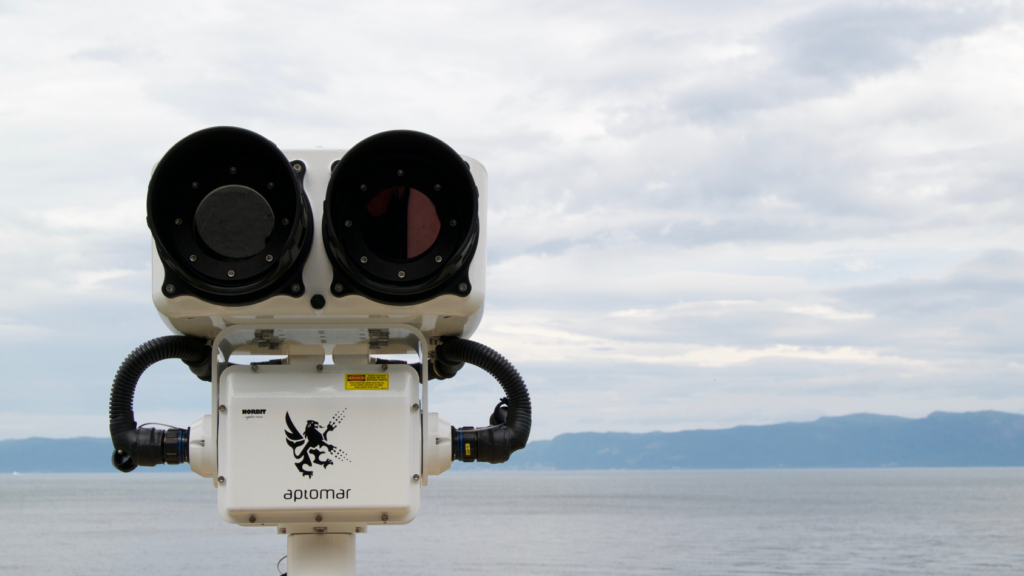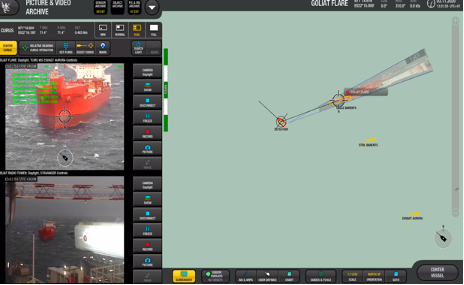Sensor Integration Platform and user interface
Common Operational Picture for emergency response
Sensor Solutions
Environmental Monitoring
NORBIT Aptomar began by developing the best possible tools for marine oil spill detection, containment and recovery operations. Our SeaCOP solution rapidly became the Norwegian national industry standard and best practice for oil spill contingency plans. The SeaCOP platform has subsequently advanced to encompass a broader range of environmental monitoring applications for the maritime industry.
Sustainable operations are paramount for all stakeholders in the maritime industry and has become a mandatory operating requirement world-wide. Environmental monitoring is an important aspect for vessels involved in critical operations as well as in day-to-day port operations. To meet these demands, NORBIT Aptomar has expanded our SeaCOP system by integrating a wide range of additional functionality. This includes weather reports, real-time metocean parameters, the detection of pollution from sensors below, on or above the sea surface. The earlier the detection of emissions results in faster responses to mitigate the damage and identification of the source.
By integrating all the data into one display improves user experience and requires less training than having to manage multiple software systems. The SeaCOP system has also been designed to share data across multiple devices within the enterprise to ensure everyone who needs access to the data has it in a rapid and reliable manner.

Maritime Security and Law Enforcement
Maritime security is a very broad term, but will normally refer to mitigation of threats such as:
- Maritime inter-state disputes
- Maritime terrorism
- Asset protection
- Piracy
- Trafficking of narcotics, people, and illicit goods
- Illegal fishing
- Environmental crimes
- Maritime accidents and disasters
Global threats are ever increasing and people, assets and environment must all be safeguarded.
The SeaCOP multi-mission decision support tool enables maritime law-enforcement organisations to integrate sensor data into one common operational picture that can be shared among stakeholders. Stakeholders, in this context, being on-scene commanders and their assets as well as shore-based control centres. It is well-documented that a common operational picture creates the basis for an efficiently coordinated operation by enhancing the communication between the involved parties.
Anti-intrusion operations are not only reserved for military purposes, it is required for civilian infrastructure as well. A company providing cruise tourism needs to ensure that all passengers are safe; a port needs to ensure that all visiting vessels are safe; and, a FPSO or an oil rig must make sure that it’s operation can continue without interrupts. Such operations have become potential targets for intrusion, and safeguarding measures are important and necessary.

Maritime Surveillance and Vessel Monitoring
Advance maritime security, powered by smart technology
NORBIT’s SeaCOP is a cutting-edge Maritime Surveillance solution that combines the power of Commercial-Off-The-Shelf (COTS) sensors—such as marine radars, cameras, and sonars—to create a flexible, high-performance system. SeaCOP is designed for versatile deployments across offshore platforms, coast guard vessels, coastal areas, waterways, and ports.
At its core, SeaCOP collects and integrates data from multiple sources, distributing real-time insights to users locally and globally. Whether monitoring a busy port or a remote offshore facility, SeaCOP delivers the critical situational awareness needed to secure maritime environments.
Tailored for the Future of Maritime Operations
As maritime security becomes more complex, SeaCOP helps operators focus on what truly matters. Its intuitive user interface is tailored for the modern operator—those who may not have decades of navigation experience but are highly proficient in digital systems and sensor integration. With the growing ability of today’s professionals to quickly interpret digital data, SeaCOP acts as a powerful decision support tool. It enables faster, safer, and smarter responses to potential threats—whether on the surface or underwater.
Real-Time Threat Detection & Response
SeaCOP enhances security through:
- Subsea infrastructure protection – Monitor vessel traffic to prevent anchor strikes and interference.
- Underwater intrusion detection – Integrate NORBIT’s GuardPoint™ sonars to detect and alert on submerged threats.
- Actionable alerts – Visualize guard zones, track alarms, and respond instantly using a unified display.
Seamless Integration with Vessel Tracking Systems
SeaCOP complements traditional Vessel Traffic Services (VTS) and Vessel Traffic Management and Information Systems (VTMIS). Integration of the SeaTarget module enhances small target detection and can share high-resolution target data directly with VTS systems, supporting a fully integrated Common Operating Picture.
A Scalable, All-in-One Solution
Whether you’re managing a single port or a regional maritime security network, SeaCOP adapts to your needs. It also integrates seamlessly with NORBIT’s Environmental Monitoring tools, such as Oil Spill Detection and Wave Monitoring, offering a comprehensive solution to today’s global marine security challenges.

Camera Station for Ships
The NORBIT Aptomar SECurus system is a high-performance, multipurpose camera system, tailored for the maritime environment. The SECurus offers functionality and performance normally only found in military graded camera systems, all available in a COTS ITAR-free package.
Key Functionality
- Stabilization in 6 degrees of freedom
- High resolution, long range thermal and daylight sensors
- Target detection and tracking
- Powerful xenon searchlight
- Augmented reality; merging of sensor data and map information for enhanced decision support
- Rugged design, easy service and maintenance
- Fully integrated in the multipurpose SeaCOP Situational Awareness and Decision Support operator interface
Operator Interface – SeaCOP
The SECurus range of EO sensor stations are fully integrated with the SeaCOP sensor and decision support platform. SeaCOP is an intuitive and easy-to-use interface that provides enhanced situational awareness and a common operational picture (COP). SeaCOP combines powerful process and decision support tools, integrating sensors and sensor platforms such as AIS, cameras, radars, sonars, drones, satellite data and more. The sensors and data sources are all integrated, processed and fused in real-time, giving the operator an unmatched situational awareness. For the operator, earlier warning results in having accurate and up-to-date information to take appropriate decisions and initiate effective counter measures.
Camera Stations for Shore-based Applications
The NORBIT SeaView series is a family of flexible and reliable multi-sensor systems, giving the industry access to an unmatched situational awareness sensor, available in various range, performance and price classes. SeaView is designed for shore-based installations. SeaView can be outfitted with a large number of short, medium or long range sensors, such as cooled and uncooled thermal imaging, polarimetric cameras, daylight and low light cameras.

NORBIT SeaDarQ Oil Spill Detection Radar
Using a high resolution marine X-band radar, the NORBIT Aptomar SeaDarQ System can automatically detect and monitor oil spills on the ocean surface. Using a combination of fast update rates, high horizontal resolution and low detection limits, the SeaDarQ oil spill system meets industry best practices and is in use worldwide protecting the marine environment. Oil spills are detected automatically, and the advanced algorithms identify even the smallest spills and reduce false alarms to a minimum.

Features
- Oil spill detection in low visibility and darkness
- Fully automated with low false alarm rate
- Range up to 4nm, based on radar height and weather conditions
- Automatic detection with spill outline and area determination
- Calculate the position, area and drift of the oil slick
- Historical playback of potential and verified detections
- Integrated with any camera system
- Integrated with ENC map, AIS and ARPA targets
- Tested and verified by NOFO and EMSA
How does it work?
OSD Radar Processors monitor the presence of capillary waves, caused by the wind passing over the water surface. It does this by detecting the radar backscatter caused by the uneven water surface. This back scatter is filtered out of normal navigation radar to give a clear image of large, hard-edged targets. Oil floating on the water surface suppresses the capillary waves, this in turn provides no backscatter to the radar. When an OSD Radar processor detects an area with no capillary waves it alarms as a possible oil spill.
OSD Radar will then measure the area of the suspected slick and will go on to calculate the speed and direction of drift of the slick.
To be operational, the radar needs wind between 2 and 12 m/s. The combo of OSD radar and EO camera provides a superior solution as each remote sensor strength compliments the weakness of the other. To measure relative thickness, the most cost efficient is using infrared camera systems, cooled or uncooled.













